Ballot counters tested in Augusta County before March primary election
AUGUSTA COUNTY – Stepping into one of the conference rooms in the Augusta County Government Center on Feb. 13, there was a rare sight to be seen.
An election ballot counter sits on the table, near the door to the room. And another. And another.
The machines spread out over three rows of tables, each row extending to the opposite side of the room.
The ballot counters' screens are folded up and out of the way, a small chamber not typically visible now accessible. Inside each is an empty insert plug for a USB thumb drive.
Normally these machines are found a handful at a time in each voting precinct. On Feb. 13, they were gathered together for testing ahead of the March 5 presidential primary.
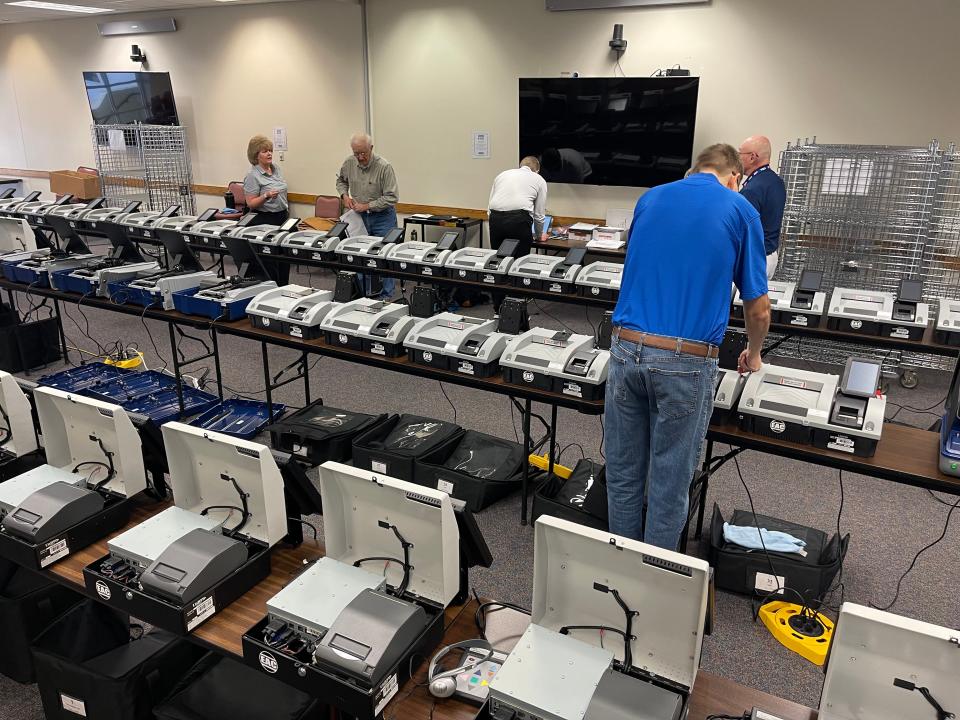
Ballot counter testing begins
Augusta County’s Electoral Board is made of three members: Marcy Reedy, Victor Ludlum, Brenda von Seldeneck. Ludlum and von Seldeneck were already present when The News Leader arrived, and Reedy arrived not long after.
“This is a very long and detailed process," Reedy said. "We’re looking for so many different things that could potentially go awry. We’re looking for the date of the election, is it right. We’re looking at the machines, are they damaged, are they functioning properly, boot up properly. We’re looking that the ballots are scanned through properly, like they should, that the machine is reading them.”
The election board was joined by staff from Election Services Online by Shoup, the county's vendor for election hardware and software. ESO Managing Partner Kimberlee Shoup Erney and her staff arrived just after 9 a.m., briefly caught up with the election board, put down their equipment, and the testing was on.
"We have to clean the thumb drives," said Shoup.
Cleaning the thumb drives
ESO staff picked up a bag of thumb drives from the Augusta County registrar's office and brought them in the room. Using a laptop that has never been connected to the internet, each thumb drive is wiped and loaded with data, telling the ballot machines which precinct they’re going to, what election to show, and who is on the ballot.
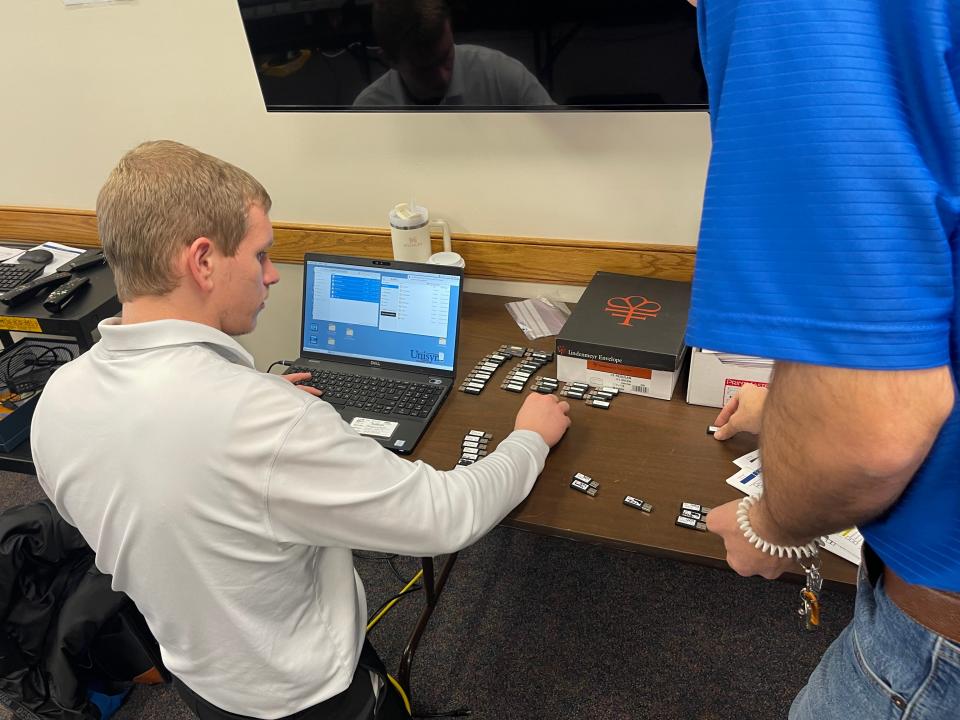
The thumb drives, also called the header cards, designate the machine to a specific precinct's ballots, meaning a vote in a Riverheads precinct can’t be run through a machine set to a North River precinct. A mix up in machine delivery can cause delays for election volunteers, such as what happened early in the morning during the Nov. 8 election in Staunton, but the ballot restrictions keep mix ups from messing with the final vote tally.
One by one, the thumb drives are matched to their respective machines, plugged in, and the compartment is sealed. A breakable clip is placed on the lock for the thumb drives, letting election workers know if it's been opened before it should have been.
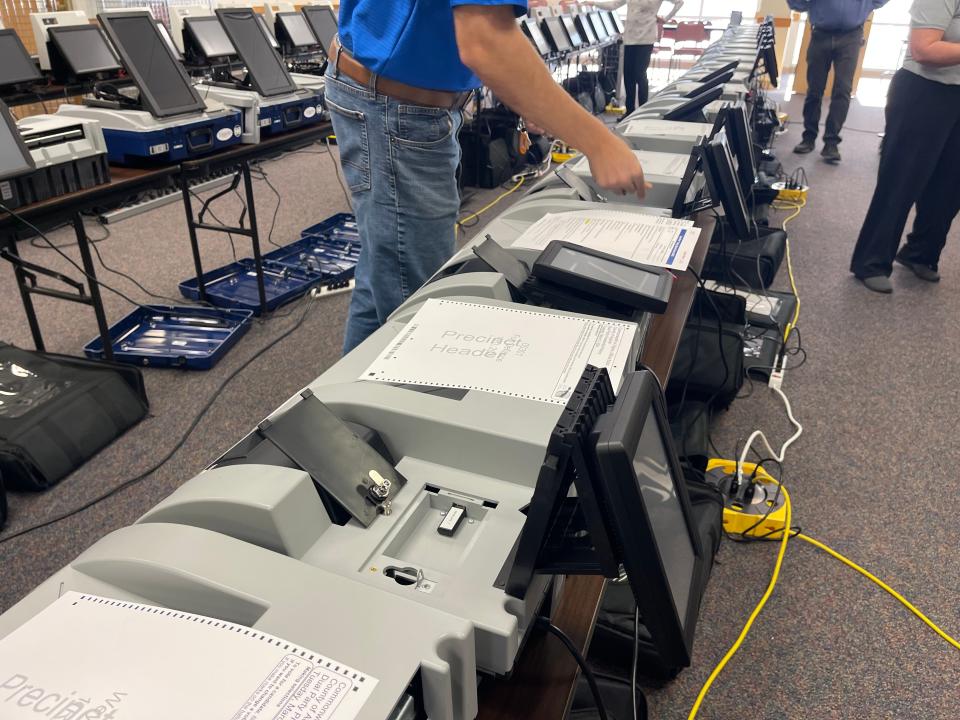
The drives create another layer of redundancy as people vote – they keep track of how many votes each candidate receives. The ballot machines themselves also do this, keeping an odometer-like tally of how many times someone has voted on the machine during this election, and another tally for how many votes have been cast on the machine since it first turned on. This information is printed out by the ballot counter onto a thicker version of common grocery store receipt paper.
Testing the ballot odometer
“No machine goes out to any precinct until we’ve already run a test deck, we’ve already practiced it, everything,” Marcy Reedy explained to The News Leader. “There’s so much redundancy, there’s so much security imparted into every single step.”
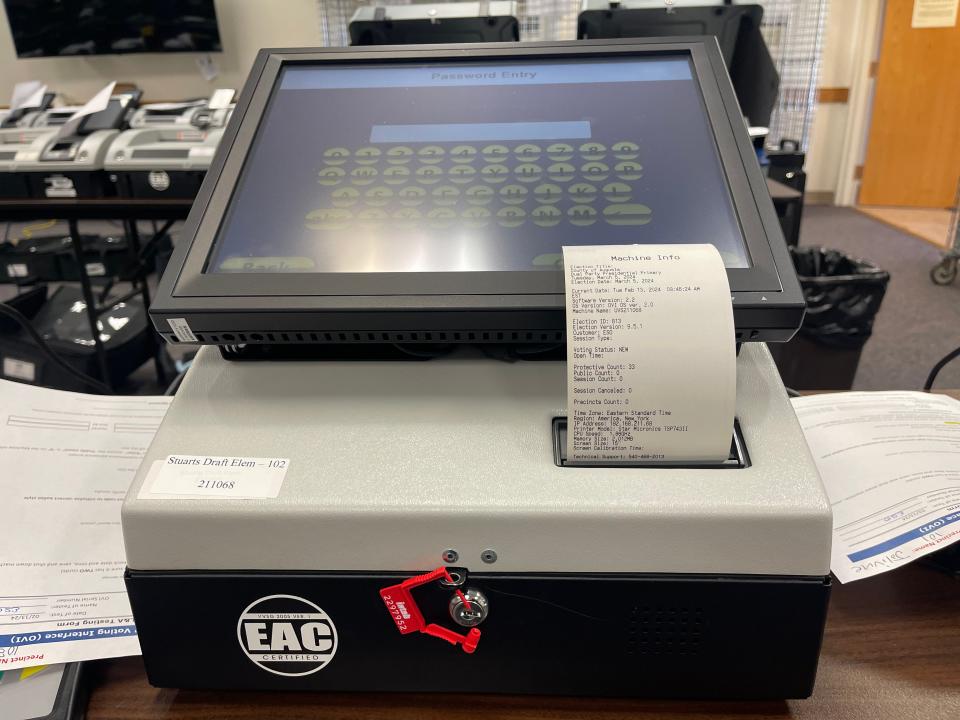
Another layer of redundancy are the ballots themselves. The machines read them, then drops them into a large bin, resembling a square garbage can, underneath.
"We have the physical ballots, which are critical," Reedy said. "We reserve those, those are our crowning gems. We have those as a layer, rescan them or count them by hand. They are preserved. Then we have the flash drive, which also preserves the memory, as a second source of the data, and the tapes."
Preliminary election results from each precinct come from the raw count provided by the ballot counter print out. The final results come after a comparison between the printed count and a manual recount of the ballots stored in the box.
The Feb. 13 testing ran a mock election on each machine. EPC staff fed a stack of test ballots through each machine containing a known number of votes for each candidate. If the machine displays the correct number of ballots for each candidate in the stack, it passes. The test ballots are then removed from the data.
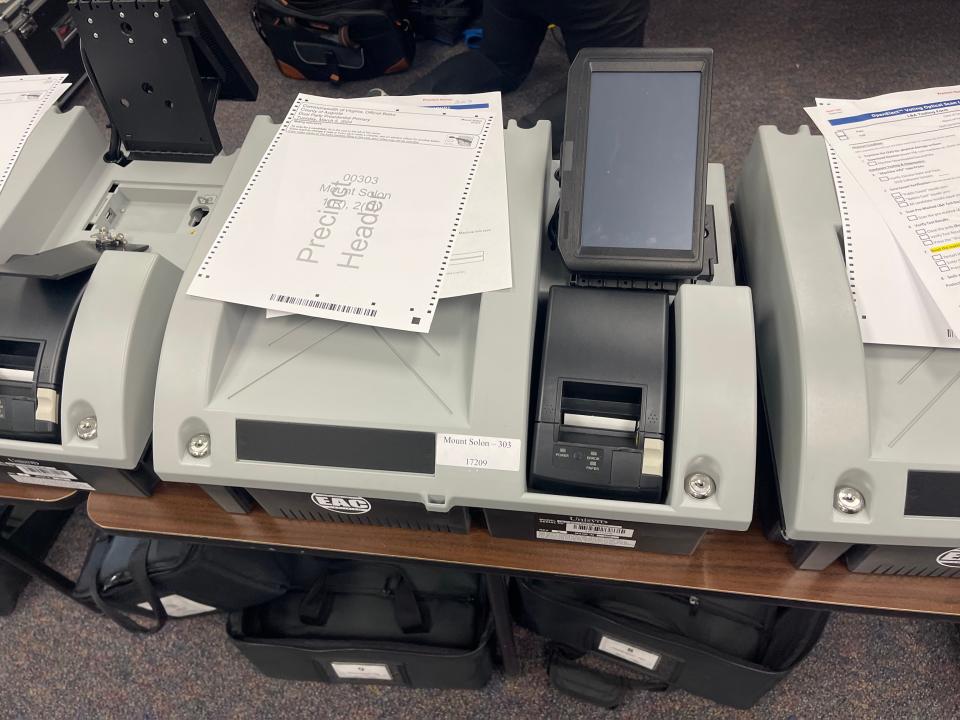
When there’s an error on site during election day, most of the time the machine is swapped with one of the several spares kept as backup, rather than trying to fix a major problem that’s gone wrong. The faulty machine is taken off the ballot container, the ballots are gathered, the new machine is put in place, and the ballots are simply run into the fresh machine.
Like the thumb drive programming computer, none of the ballot readers can connect to the internet. The readers do not have the hardware to connect to the internet in the first place, eliminating the possibility of remote ballot tampering.
"These machines aren't talking to anything," Reedy said. "It is an isolated, self-contained system."
ADA counters tested the same way
Some of the machines are set up with headphones, tactile buttons, and extra accessibility options for people who need extra accommodations to vote independently. These machines are not used often, at least one had a lifetime vote odometer count in the 20s, but as long as one person needs the help, the county will be able to provide it in accordance with the Americans with Disabilities Act. All of these features were tested on Feb. 13.
"They may have a physical disability, but they want to vote independently and not have someone else mark the ballot," Reedy said. "They want a private ballot, to vote independently, this is a resource for that."
Many of the machines came to Augusta County in 2016, when the county switched from touch-screen voting for paper ballots. Since then, newer machines have been purchased, dividing the ballot counters into four categories: older ballot counters, newer ballot counters, older ADA ballot counters, and newer ADA ballot counters. Practically though, there is not much difference between the four categories beyond accessibly options.
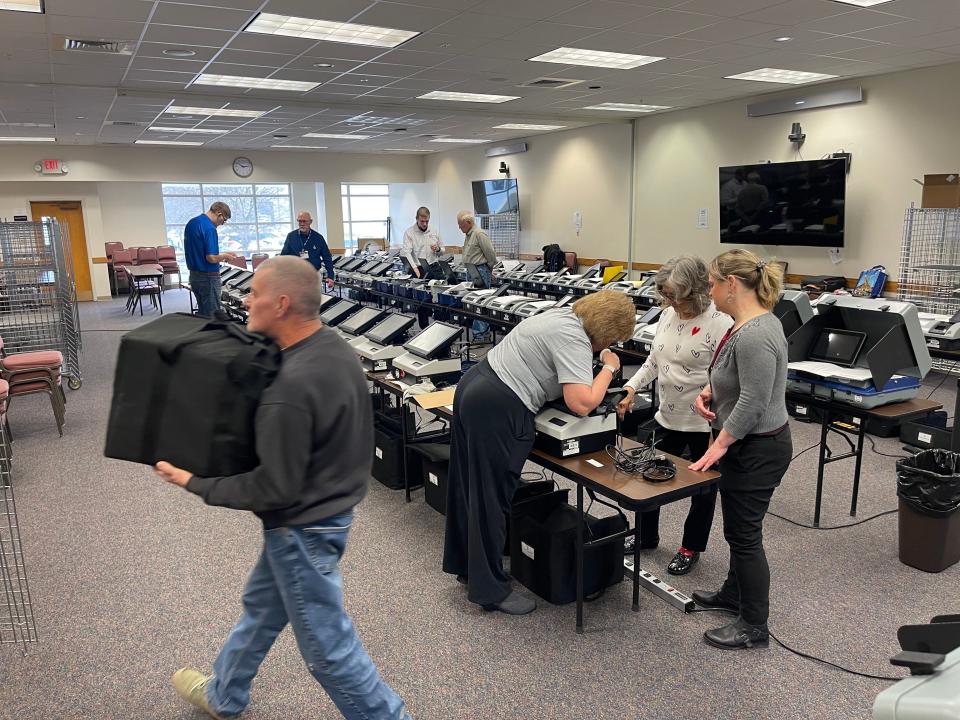
The testing continued past 11 a.m. There are more meetings for the election board before the March 5 primary. Potential voters looking for more information about the election can be found below:
Augusta County March 5 primary election
Polling places will be open on Election Day from 6 a.m. to 7 p.m. If the voter is uncertain where they should vote, call the registration office at 540-245-5656. Voters must bring acceptable ID.
Voting in-person absentee is at the Government Center, Monday through Friday starting Jan. 19 from 8 a.m. to 1 p.m. and 2 p.m. to 5 p.m.
Staunton March 5 primary election
The polls will be open from 6 a.m. to 7 p.m. on March 5. Voters uncertain of their polling location can find it online through the citizen portal.
Early voting is running from Jan. 19 to March 2 in the lobby of Staunton City Hall from 9 a.m. to 5 p.m. Monday through Friday, and on two Saturdays, Feb. 24 and March 2.
Waynesboro March 5 primary election
Voters uncertain where to vote on March 5 should check their voter registration card or call the Waynesboro registrar’s office at 540-942-6620.
In Waynesboro, early voting began Jan. 19 and will run through March 2 at the Registrar’s office, 501 W. Broad Street in Waynesboro. The polls are open Monday through Friday, 9 a.m. to 5 p.m., with an hour for off for lunch at 1 p.m., and two Saturdays, Feb. 24 and March 2, from 9 a.m. to 5 p.m.
Lyra Bordelon (she/her) is the public transparency and justice reporter at The News Leader. Do you have a story tip or feedback? It’s welcome through email to lbordelon@gannett.com. Subscribe to us at newsleader.com.
More: Riverheads honors former assistant principal; Wilson, MBU theater; and Eco-Camp: The Chalkboard
More: Sentencing for child killer to take place Friday in Augusta County Circuit Court
This article originally appeared on Staunton News Leader: Ballot counters tested in Augusta before March primary election

